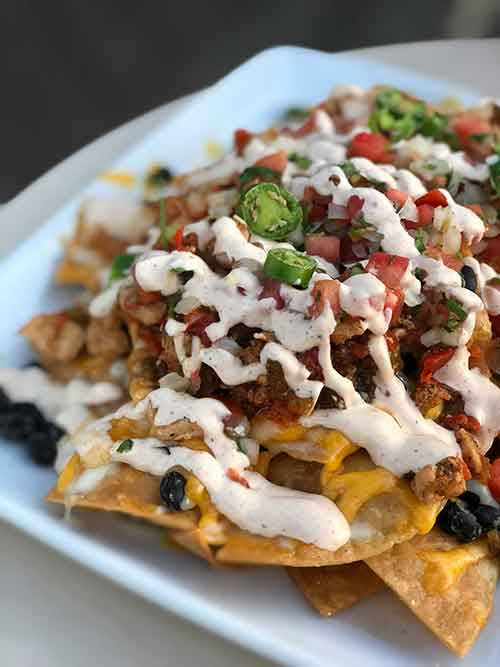Jose Mier knows his Mexican food and one of our Sun Valley, CA Mexican restaurants, RJM Mexican Grill serves up some delicious nachos. If you’ve ever wondered how this delectable appetizer (and sometimes whole meal) came about, read on.

Nachos, a beloved snack with humble beginnings, have evolved into a global culinary phenomenon. Originating in Mexico, this delectable dish has transcended borders and cultural barriers, captivating the hearts and taste buds of people worldwide. In this comprehensive exploration, we delve into the rich history, cultural significance, culinary diversity, and contemporary interpretations of nachos. From its inception as a simple snack to its modern-day variations, nachos represent not only a culinary delight but also a symbol of cultural exchange and gastronomic innovation.
Historical Origins:
The story of nachos begins in the northern Mexican border town of Piedras Negras in the 1940s. Ignacio “Nacho” Anaya, a maître d’ at the Victory Club restaurant, is credited with inventing the dish. Legend has it that one evening, a group of hungry American military wives arrived at the restaurant after closing hours. With limited ingredients available, Anaya improvised by layering tortilla chips with melted cheese and jalapeño peppers, creating a simple yet satisfying snack. The dish was an instant hit, and Anaya named it “Nachos Especiales” after his own nickname. From its modest origins, nachos gained popularity across the border in Texas and eventually spread throughout the United States, becoming a staple in Tex-Mex cuisine.
Cultural Significance:
Beyond its culinary appeal, nachos hold cultural significance as a symbol of cross-cultural exchange and assimilation. The melding of Mexican and American influences in the creation of nachos reflects the interconnectedness of culinary traditions. Nachos exemplify the fusion of flavors and ingredients from different cultures, showcasing how food can serve as a bridge between communities. Moreover, nachos have become ingrained in popular culture, appearing in movies, television shows, and sports events. They are not merely a snack but a cultural icon that embodies the spirit of shared enjoyment and conviviality.
Culinary Diversity:
One of the most fascinating aspects of nachos is their culinary diversity. While the classic version features tortilla chips topped with melted cheese, jalapeños, and salsa, the possibilities for customization are endless. From protein options like seasoned ground beef, shredded chicken, or grilled steak to vegetarian alternatives such as black beans, roasted vegetables, or tofu, nachos can cater to a wide range of dietary preferences. Creative variations abound, with chefs experimenting with different cheeses, sauces, and toppings to put their own unique spin on this timeless snack. Whether it’s loaded nachos piled high with an assortment of ingredients or gourmet nachos featuring artisanal cheeses and exotic flavors, there’s no shortage of innovation in the world of nachos.
Regional Variations:
Across the globe, nachos have inspired countless regional variations, each reflecting the local culinary traditions and ingredients. In the United States, regional interpretations of nachos abound, with variations like Hawaiian nachos topped with pineapple and ham or Southern-style barbecue nachos featuring pulled pork and tangy barbecue sauce. In Mexico, nachos are often served as a simpler snack, with toppings like refried beans, queso fresco, and pickled jalapeños. In South Korea, “kimchi nachos” have gained popularity, incorporating the spicy and tangy flavors of kimchi into the dish. Whether it’s a street food vendor in Thailand serving up Thai-inspired nachos or a trendy restaurant in Australia putting a modern twist on the classic recipe, nachos continue to inspire culinary creativity around the world.
Health Considerations:
While nachos are undeniably delicious, they are often associated with indulgence and excess due to their high calorie and fat content. However, with mindful ingredient choices and portion control, nachos can be enjoyed as part of a balanced diet. Opting for whole grain or baked tortilla chips, lean protein sources, and plenty of vegetables can help make nachos a more nutritious option. Additionally, incorporating homemade salsa or guacamole as toppings can provide vitamins, minerals, and healthy fats. By making thoughtful choices about ingredients and serving sizes, individuals can savor the flavors of nachos without compromising their health goals.
Conclusion:
In conclusion, nachos represent much more than just a tasty snack—they embody the intersection of culture, creativity, and culinary innovation. From their humble beginnings in a small Mexican town to their status as a global culinary phenomenon, nachos have captured the imaginations of food enthusiasts everywhere. Whether enjoyed as a quick bite at a sports bar, a party platter at a gathering, or a gourmet dish at a fine dining restaurant, nachos continue to hold a special place in the hearts and appetites of people around the world. As we celebrate the diversity and versatility of nachos, let us also acknowledge their ability to bring people together, one delicious chip at a time.